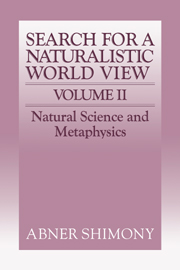Book contents
- Frontmatter
- Contents
- A MEASUREMENT IN QUANTUM MECHANICS
- B QUANTUM ENTANGLEMENT AND NONLOCALITY
- C COMPLEX SYSTEMS
- D TIME
- E THE MENTAL AND THE PHYSICAL
- 19 Quantum physics and the philosophy of Whitehead
- 20 Reflections on the philosophy of Bohr, Heisenberg, and Schrödinger
- 21 Wave-packet reduction as a medium of communication
- Index
19 - Quantum physics and the philosophy of Whitehead
Published online by Cambridge University Press: 05 June 2012
- Frontmatter
- Contents
- A MEASUREMENT IN QUANTUM MECHANICS
- B QUANTUM ENTANGLEMENT AND NONLOCALITY
- C COMPLEX SYSTEMS
- D TIME
- E THE MENTAL AND THE PHYSICAL
- 19 Quantum physics and the philosophy of Whitehead
- 20 Reflections on the philosophy of Bohr, Heisenberg, and Schrödinger
- 21 Wave-packet reduction as a medium of communication
- Index
Summary
INTRODUCTION
One of the virtues which Whitehead claims for his philosophy of organism is that it provides a conceptual framework for quantum theory (SMW chapter 8, PR 121–2 and 145). The theory which he has in mind is the ‘old’ quantum theory, consisting of the hypotheses of Planck (1901) and of Einstein (1905) that electromagnetic energy is emitted and absorbed in quanta, together with Bohr's model of the atom (1913) in which discontinuous transitions were supposed to occur between discrete electronic orbits. The philosophy of organism was presented in a preliminary form in the Lowell Lectures of 1925 (published in the same year as SMW) and in its most systematic form in the Gifford Lectures of 1927–28 (published as PR in 1929). It was during the years 1924–28 that de Broglie, Schrödinger, Heisenberg, Born, Jordan, Bohr, Dirac, and others developed the ‘new’ quantum theory, which was more systematic than the old, much more successful in its predictions, and more revolutionary in its departures from classical physics. Whitehead never refers to the new quantum theory, and it would be unreasonable to expect that even so imaginative a philosopher and scientist could have anticipated it except in the most general terms. Nevertheless, it is important in evaluating the philosophy of organism to determine how well its physical implications agree with quantum theory and with contemporary microphysical theory in general. To do this is the primary purpose of the present essay.
- Type
- Chapter
- Information
- The Search for a Naturalistic World View , pp. 291 - 309Publisher: Cambridge University PressPrint publication year: 1993



